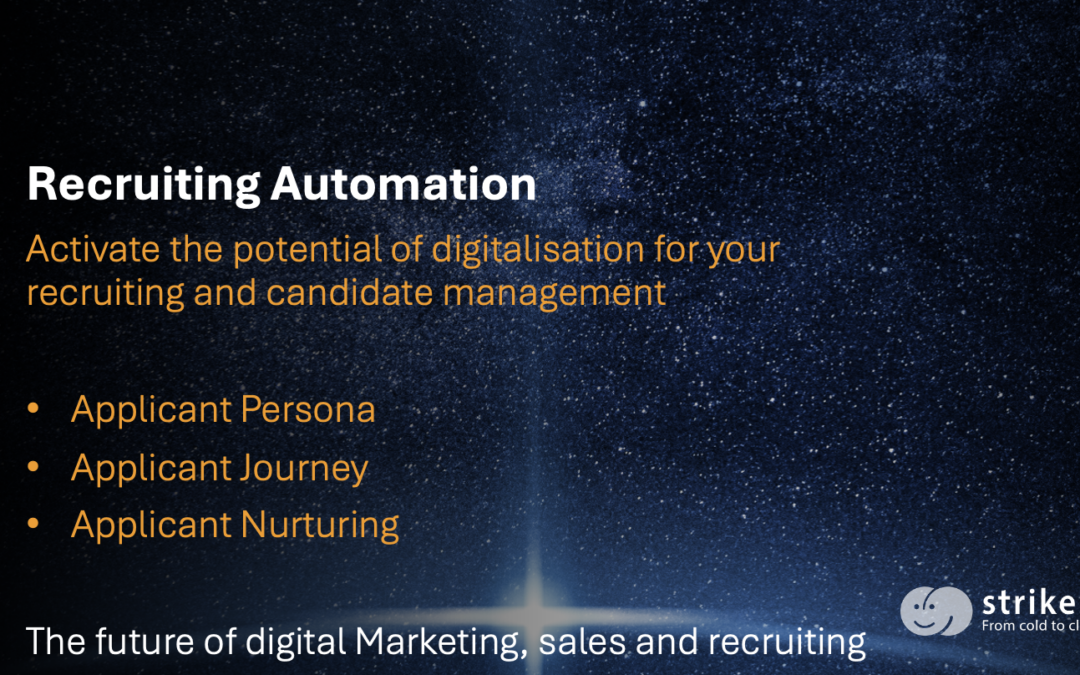The profiling of ideal customers with the buyer persona concept is becoming increasingly popular with the introduction of modern lead management and marketing automation platforms. If you want to generate more qualified prospects and develop them to the point of closing, you should know the prospects and develop empathy for them. Profiling with the buyer persona profile is ideal for this. The profile helps marketing and sales to better adapt to prospective customers, generate relevant content and develop the right processes for the development of prospective customers. With a customer journey analysis, you can better understand the buying journey and buying process of (potential) customers and can optimise your approach, content and lead/existing customer nurturing processes. This method, which optimally supports marketing and sales, can also be used very well in HR for recruiting and onboarding. For many companies, the pressure to fill vacancies is even greater than in sales.
The ‘counterpart’ to the marketing automation process is Recruiting automation. Companies use it to profile their ideal prospects with applicant persona profiles, analyse the applicant’s journey in a applicant journey and map it with the appropriate approaches and content modules in applicant nurturing processes.
The questions:
What are your strengths?Where do you see yourself in 5 years?Why do you think you are the right candidate for this position?
are no longer in keeping with the times – like cold calling to market an investment. Today, the applicant asks why the company believes it is the right employer. And he/she judges the company based on the application process and communication during the recruitment phase. For both areas, it is helpful to create a applicant persona profile and to optimise the process and communication based on this.
Applicant persona profile
You should profile a applicant persona for each position. Always start with a name and a picture. Perhaps you have already recruited an ideal candidate for the vacant position in the past. Then simply ‘borrow’ the name and picture for your profile. If you have not yet had an ideal applicant for the position, use an artificial name such as:
Steve Sales ManagerMike Mechatronics Engineer- M
onika Marketing Manager etc.
The name should of course not be a restriction to a gender, but only an indication of the typical applicant. The profile is not a collection of selection criteria, it should describe the typical applicant, his/her profile and behaviour.
The next step is to define the ‘demographic’ data relevant to the position, e.g:
Previous positionAgeGenderMarital status- C
hildren Education and trainingExperienceSpecialityetc.
The ‘knitting pattern’ of your applicant persona / motive structure
How is your applicant persona ‘knitted’? What drives them? For an individual applicant, the well-known motive structure analysis tools (Reiss, DISG, Thomas International INSIGHTS & Co.) are often used. With your applicant persona, you can also define, for example, whether the typical, ideal applicants correspond to these type characteristics:
Red - dominance, status, recognition, powerYellow - curiosity, innovation, discoveryGreen - security, balance, harmonyBlue - ZDF Facts, figures, data
In addition to the applicant persona, you should define other characteristics that describe your ideal candidate. These could be the following characteristics, for example:
Professional and personal goalsDrivers/motivators‘Influencers’Life goalsValues Career plansPrioritiesIntended focus of activityDecision criteriaObstaclesetc.
Expertise diagnostics and development with KODE®
Another important aspect of the applicant is his/her competences. The KODE® method, for example, can be used to define the necessary competences. KODE® is used for competence diagnostics and development. With the help of the KODE® competency atlas, you select the 16 relevant competencies for the vacant position from the 64 core competencies and thus create the requirements profile. When the applicants complete the KODE® questionnaire, you can compare the actual and target competences, compare the competences of the different applicants and, if necessary, create a competence development plan.
In general, the Candidate Persona Profile supports you in focussing your activities on the desired applicants. In particular, you can use the findings when formulating job descriptions, job adverts and in all communication with the applicant.
Candidate Journey
With the customer journey analysis, you explore the stages in the applicant journey and the motivation of the applicant to enter the journey. For each stage in the application process, you analyse which goals, questions and pain points your desired applicant has and what content you can offer to lead him/her to the next stage or to avoid dismissal.
The stages in the application process:
Invitation to tenderAttentionSearchInformApplySelection processNegotiationSelection/decisionOnboardingEveryday workOutplacement
Candidate nurturing
Another ‘borrowing’ from the marketing sector can be processes for the development of prospective customers – lead nurturing. This involves automatically sending prospective customers individually relevant information at the appropriate stage in the buying process. This procedure can also be adapted very well for the recruiting process in order to improve the candidate experience. In the traditional application process, applicants often experience that they hear nothing more from the company after applying. Often enough, applicants do not even receive a confirmation of receipt of their application. After a few weeks, they wonder whether they are even still in the selection process. This ‘hanging in the air’ and ‘non-communication’ does not exactly increase the attractiveness of the company for the applicant. With candidate-nurturing processes, you send the interested party relevant information at the appropriate stage in the application process. For example, about the company and the relevant position – customised but automated. The applicant thus receives regular information from your company. This gives the applicant a good picture of the company and position, prepares them for possible interviews and supports the candidate experience and ultimately the reputation of your company.
Conclusion
In the ‘war for talent’ and in times of a shortage of skilled labour, companies must position themselves optimally in order to find the few potential employees available on the market and get them excited about the position and the company. The wide range of marketing automation platforms available on the market can be used as HR automation with speeches, content modules and processes adapted to the HR sector. The basis for this is empathy for the applicants. The applicant profiling methods described above (candidate persona and candidate journey) are ideal tools for building this empathy. Candidate nurturing processes automatically accompany the applicant from the search


